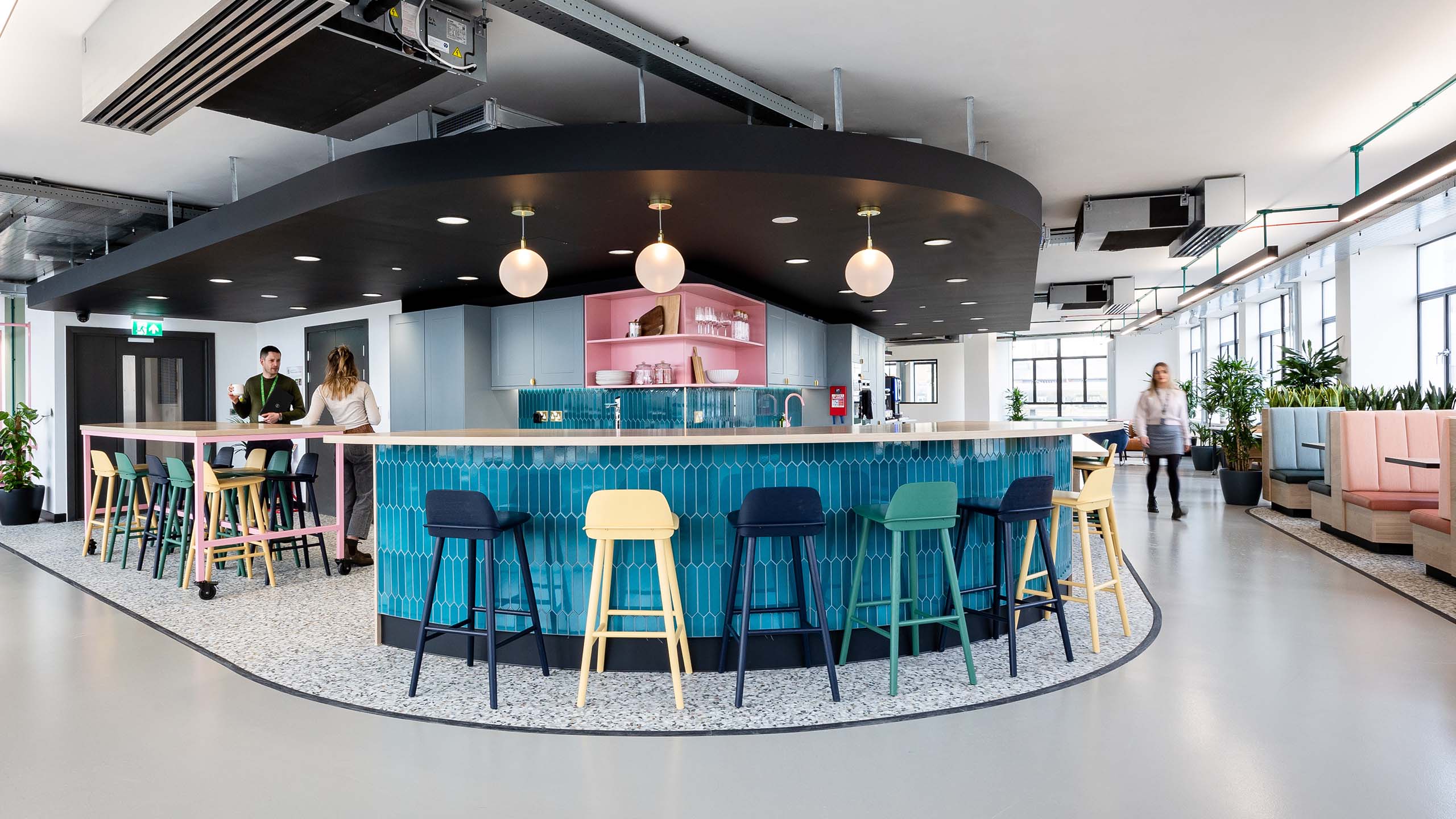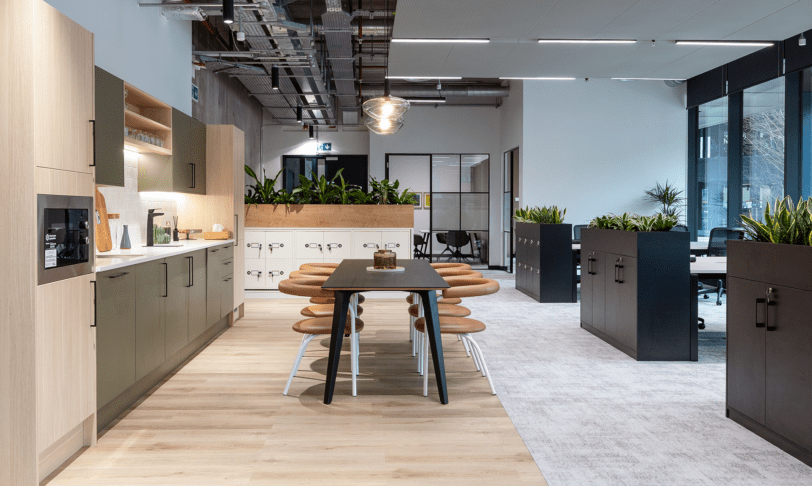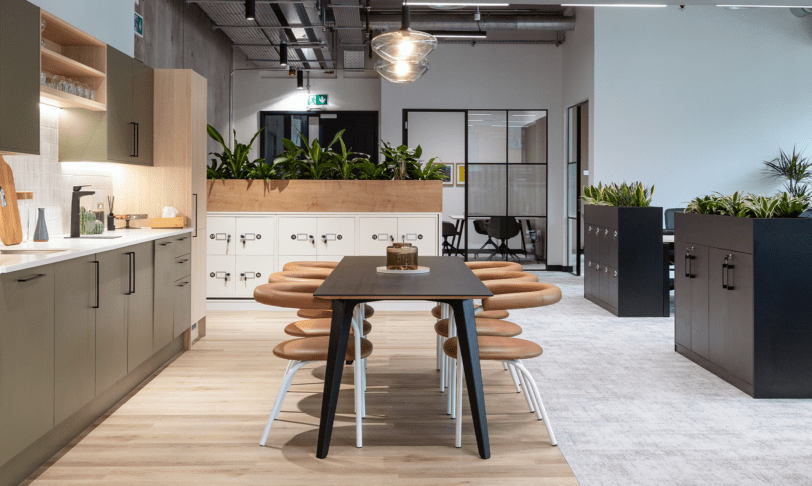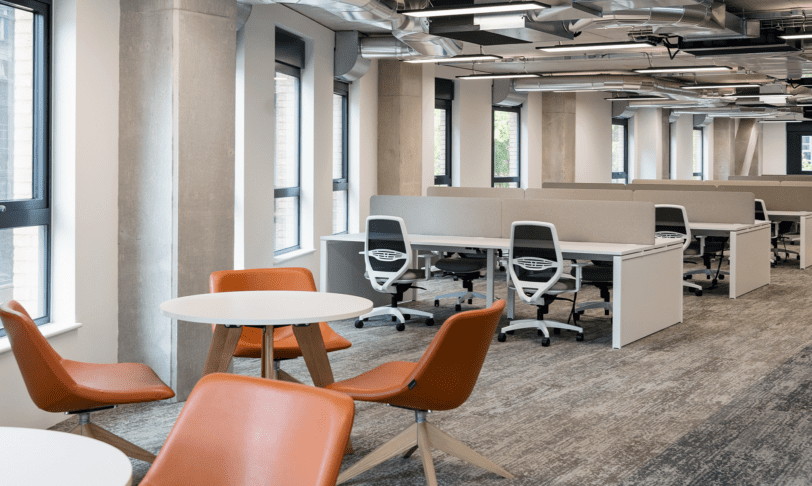Designing better behaviour
When it comes to designing behaviours into the workplace, we can subtly use the framework of Choice Architecture to inspire people to make better choices. In other words, our environment influences our behaviour and this blog looks at its application in office design, specifically its impact on culture.
Choice architecture and how it influences culture
In 2008 Richard H. Thaler and Cass R. Sunstein shone light on a theory which has been quietly underpinning the advertising industry since its inception.
Their book Nudge – Improving Decisions About Health, Wealth and Happiness introduced the concept of Choice Architecture. Presumably prompting many ad execs to break out in cold sweats as Thaler and Sunstein revealed the explicit ways marketers use psychology to part us from our cash.
Psychologists have known for a long time that telling people how to behave is not effective. Even showing them does not always lead to people adopting specific behaviours.
Trickier still, decades of psychological research have shown that providing people with information can be effective in changing their attitudes, but this will not always be predictive of behaviour.
Several theories focus on the power of context to explain this discrepancy between attitude and behaviour. In other words, our environment influences our behaviour more than we might think.
Culture and the workplace
Most people instinctively understand that their environment influences their behaviour. The smell of citrus, pine or fresh coffee sells houses. And if a space is already messy we’re far less likely to put things away. However, when it comes to office space, it’s easy to underestimate the many subtle features which can prompt specific behaviours.
Let’s think about it in a slightly different way. If your offices are rigidly designed with glass spaces for executives and a closed-door policy, you won’t be promoting the open conversations, creativity or collaboration that is likely to occur in a more relaxed and informal environment.
Equally, if you want to encourage conversations across departments, where you place your coffee and kitchen facilities will help facilitate those chance encounters that start to build relationships and connections.
If you want to encourage cross-working between different floors, how you connect those floors is important. A lift lobby won’t give you what you need, but a central staircase that brings people into each other’s working space will.
These physical changes to an environment can have a big impact on people’s behaviour.
At Interaction we look at the culture that businesses want to create and then consider the behaviours they need to promote to reach their business objectives.
This forms part of the workplace strategy that can inform and influence every stage of the design, build and fit-out of the offices we create.

Understanding workplace behaviours
The theory of Choice Architecture is based on three key aspects:
- How options are presented.
- How they evoke particular associations (and the benefits that result from a decision).
- Making one option significantly easier to choose than others.
When it comes to designing behaviours into the workplace, we can subtly use this framework to inspire people to make better choices. For example, when it comes to things like health, collaboration and even creativity. However, there are other methods too.
Nudge theory was explored by Richard Shotton in his fascinating book The Choice Factory. Shotton identified 25 specific traits of human behaviour that influence how people respond to adverts. It’s an interesting read with some crossover to behaviour in the workplace.

The fundamental attribution error
Shotton describes a classic experiment. Forty trainee Catholic priests were separated into three groups. One group was told they were late for an urgent meeting. Another was told they needed to attend the meeting immediately. The final group was told they had a few minutes to spare. On their way to the meeting, they passed a person in distress.
Only those who felt like they had time to spare stopped to help.
The objective of the experiment was not to test the priests’ willingness to help. It was to demonstrate that context contributed to their behaviour. As Shotton says, “There’s the tendency to overestimate the importance of personality, and underestimate that of context.”
In the workplace environment, we need to be aware of context and its impact on behaviour. Biophilia and connections with nature, relaxing spaces and carefully thought-through foot flow can create an atmosphere conducive to knowledge-sharing and collaboration. However, a business with a focus on heads-down individual work, or a competitive sales culture, may need a different space. One that is more defined, with focussed lighting and clearly delineated private spaces.

Social proof
If you see a group of people standing around a tree and looking up, you will crane your neck to see what they’re looking at. This is just the same when you’re in a supermarket and you reach for the market–leading brand. We naturally do what we see or know others do.
This is demonstrated in a workplace environment. We mirror the behaviours of others around us. If we see that people get rewarded for behaving in a certain way, we are likely to adopt the behaviour ourselves.
We can consider this when designing out sedentary behaviour. Whether it’s group Pilates sessions, set paths for walking meetings, cleverly situated tea points or simply a leadership culture of walking the floors and always taking the stairs.
In his 1979 book The Ecological Approach to Visual Perception, psychologist James Gibson outlines Affordance Theory. This is the idea that clues in our environment suggest possibilities for action, and these clues change with the intentions and capabilities of those within that environment.
For instance a small set of stairs will form an impenetrable barrier to a crawling child at their base, but will provide a seat for a tired child or a way to get to the floor above for an adult.
From this we can understand that the same aspect of the environment provides different “affordances” to different people.
In the workplace this translates to having multi-use objects and areas with clear wayfinding design elements. These might take the form of paths or edges to help users subconsciously see all possible uses of the space.
Some other factors to consider include:
- Sit/stand desks can (of course) encourage less sitting.
- Desks placed on carpet islands encourage people not to walk on the carpet, which was especially useful when social distancing was crucial.
- Limiting the number of rubbish disposal points on a floor means people have to get up and move to throw waste away.
- Less printers mean people walk more (and don’t print without thinking).
- Standing areas can encourage standing meetings, which have been proven to be shorter in duration and often more efficient.
Distinctiveness
As human beings we are hardwired to notice what is unusual. We will quickly spot a person with a pink Mohican on a train full of suited commuters. While we might easily be able to see this application in advertising, how does it apply to the workplace?
A brand personality is conveyed externally through marketing. Equally, how the brand lives is reflected across a business’s workspace – both by aligning with the external brand for the sake of visitors, and by cementing the employee brand to those who work in the building.
Often, it’s tiny touches that really bring a brand’s spaces to life, from furniture and furnishings to the art on the walls and the naming of the meeting rooms. In order to build a strong, well-integrated culture, it’s vital that business ensure brands consistency across their space, giving those that use the space a collective sense of a distinctive identity.
Habitat
A lot has been written about the acceleration of change in the workplace. And 2021 will see this continue as a hot topic.
In recent years, there has been a changed understanding of the office and its purpose. The importance of community, belonging, flexibility and dynamic arrangements have all been heightened. This year has highlighted even more what we value most about the office – what the workplace does best; collaboration and culture.
Our working days have been shaped by a new work environment with different environmental nudges; the lure of a comfy chair, the short walk to the fridge, the perceived ease of sending another email rather than walking to someone’s desk or making a call.
When we return to the office it’s possible our unconscious habits will have adjusted, so the workplace may have to adjust accordingly.
On a fundamental level, people are creatures of routine. We easily adopt the same morning routine. Sleeping on the same side of the bed. Stepping into our trousers with the same leg every time.
2020 forced us to change our habits. And it’s been eye-opening to see how quickly people can adapt to new situations. We know that change is a constant. And if we want to keep changing and adapting, we’re going to have to learn to break our habits and navigate through disruption.
However, disruption isn’t necessarily a bad thing. In fact, it might be vital for the long-term success of a business.
A Harvard Business Review article Change for Change’s Sake put this clearly:
“A company periodically needs to shake itself up, regardless of the competitive landscape. Even if the external environment is not changing in ways that demand a response, the internal environment probably is. The human dynamics within an organization are constantly shifting — and require the organization to change along with them.
“Over time, informal networks mirror the formal structure, which is how silos develop. Restructuring gets people to start forming new networks, making the organization as a whole more creative. It also disrupts all the routines in an organization that collectively stifle innovation and adaptability.”
Positive disruption
Disruption is of course difficult – it breaks habits. Habits which generally allow us to free up space in our brain to make decisions. We rely on mental shortcuts, called judgmental heuristics, to ease our cognitive load, enabling us to make quick decisions with little conscious effort. But we know that just doing the ‘same old’ is dangerous when it comes to business.
Nudges in the physical environment can exploit or reprogram these judgmental heuristics to guide the desired behavioural outcome. These nudges can help a company manoeuvre through times of disruption while creating new ways of working, tackling challenges and unspoken norms.
We can use nudge theory in workplace design to reflect our changing habits and needs.
Spaces can be evolved by creating designs that enable desired behavioural changes – more focus on facilitating togetherness and social behaviours or, more measurably, higher staff retention, fewer sick days or better Glassdoor scores.
Space to thrive
At Interaction we believe everyone should have a space in which they can thrive.
This leads us to enable some of the world’s best work by creating the world’s best workspaces, built to encourage positive behaviours at every level.
If you’d like to change the way your company works, get in touch today.
Understand what contributes to bad office design and you can avoid letting it sneak into your workplace plans. At Interaction, we help organisations every step of the way from workplace strategy to office design services, office fit-out and refurbishment to furniture consultancy. We ensure your office is a space in which your team thrives. Get in touch to find out more.

 Sit-stand desks at
Sit-stand desks at  Inset carpets at
Inset carpets at 

